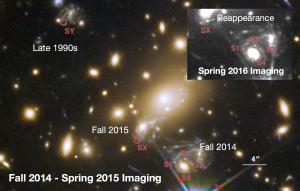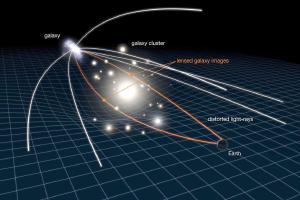Blog
Tipping the Scale
17 May 2023
 Kelly,et al
Kelly,et alThe cosmos is expanding at an ever-increasing rate. This cosmic acceleration is caused by dark energy, and it is a central aspect of the evolution of our universe. The rate of cosmic expansion can be expressed by a cosmological constant, commonly known as the Hubble constant, or Hubble parameter. But while astronomers generally agree this Hubble parameter exists, there is some disagreement as to its value.
The parameter is usually measured in terms of kilometers per second per megaparsec. This means that if we looked at a galaxy a megaparsec away (about 3.3 million light-years), then the speed at which the galaxy moves away from us in kilometers per second would be the value of the Hubble parameter. The bigger the value of the parameter, the faster the universe is expanding.
There are lots of ways to measure the Hubble parameter, but they generally fall into two categories. One general method uses the cosmic microwave background. While the cosmic microwave background is almost a perfect blackbody, there are small fluctuations in its temperature. The scale of these fluctuations tells us how much the universe has expanded, which in turn tells us the rate of cosmic expansion. This approach gives a Hubble parameter of about 67 – 68 (km/s)/Mpc.
The other approach looks at distant supernovae. One type of supernova known as Type Ia has a fairly uniform maximum brightness. So if you know the distance to a Type Ia supernova, you can compare its apparent brightness to its actual brightness, and calculate cosmic expansion. This relies on knowing the distance to the supernova’s galaxy, which relies on a complex set of distance calculations known as the cosmic distance ladder. This approach gives a Hubble value of about 71 – 75 (km/s)/Mpc. There is a third approach, using astrophysical masers emitted from the accretion disks of black holes, but so far this has had mixed success.
The upshot of all this is that two very good, very accurate measures of cosmic expansion give contradictory results. The precision of these results is good enough that we now know one or both of them must be wrong. It’s known as the Hubble tension problem. One solution to this problem would be to find a new way to measure expansion that doesn’t rely on the cosmic distance ladder or the cosmic microwave background. The maser approach might succeed in time, but recently a team has presented a fourth approach. One that involves a supernova and a bit of gravitational lensing.1
 NASA, ESA, L. Calcada
NASA, ESA, L. CalcadaGravitational lensing is typically seen with galaxies. If a galaxy is between us and a more distant quasar, then light from the quasar is lensed around the closer galaxy so that we see multiple images of the distant object. Since different lensed paths around the galaxy have different distances, we see each image of the quasar shifted slightly in time. The difference can be tens or hundreds of years, which is tiny on the time scale of quasars. But for something like a supernova, gravitational lensing could let us observe the supernova multiple times. This is exactly what happened with a supernova nicknamed Refsdal.
The supernova was first observed in 2014. It was nicknamed Refsdal after Norwegian astronomer Sjur Refsdal, who first proposed the idea of time-delayed supernovae in 1964. The Refsdal supernova happened to be located in a gravitationally lensed galaxy. When astronomers realized this, they used computer models to predict when the supernova would appear again. They estimated it should appear again sometime in 2015-2017, and sure enough in 2015 it appeared again. This let astronomers predict other appearances. By 2018, astronomers had confirmed half a dozen appearances of SN Refsdal, which leads us to a new way to calculate cosmic expansion.2
With multiple observations of Refsdal, the team could calculate the actual distance of the lensed light paths. By comparing this to the apparent angular separation between appearances, the team could determine the true distance of the lensing galaxy. Comparing this to its redshift lets you calculate the Hubble parameter. This approach doesn’t rely on either the distance ladder or cosmic background, so it is a completely independent way to measure cosmic expansion.
From this, the team calculated a Hubble parameter of 63 - 70 (km/s)/Mpc, which best agrees with the Cosmic Microwave Background result. The uncertainties are large enough that it could be said to agree with the distant ladder results, but that’s a bit of a stretch. From this result, it seems like the cosmic background is the more accurate value.
This is only one result, so it isn’t enough to solve the Hubble tension problem, but it’s a good start. And if we can find other Refsdal-like supernovae, it could settle the matter in time.